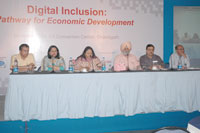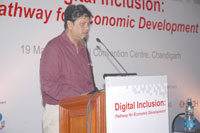 Senior officials from three Northern Indian States and Union Territories- Punjab, Chandigarh, and Haryana, met during a recently held conference to recognise the progress and successes already achieved in the field of e-Inclusion and to consider the challenges that still remain. The conference saw the outcomes in the end of all discussions, aligned with its objectives, that, in these difficult economic times, it is more necessary than ever to support vulnerable people in our society. ICTs constitute an essential tool to achieve this objective. Joint action in the area of e-Inclusion can at the same time contribute to creating new jobs and to improving their quality, for example in the sector including putting in place activities for unemployed people. Better digital inclusion will contribute to strengthening the main asset of India: its human capital.
Senior officials from three Northern Indian States and Union Territories- Punjab, Chandigarh, and Haryana, met during a recently held conference to recognise the progress and successes already achieved in the field of e-Inclusion and to consider the challenges that still remain. The conference saw the outcomes in the end of all discussions, aligned with its objectives, that, in these difficult economic times, it is more necessary than ever to support vulnerable people in our society. ICTs constitute an essential tool to achieve this objective. Joint action in the area of e-Inclusion can at the same time contribute to creating new jobs and to improving their quality, for example in the sector including putting in place activities for unemployed people. Better digital inclusion will contribute to strengthening the main asset of India: its human capital.
 The one day Conference- ‘Digital Inclusion: A Pathway for Economic Development’ held on 19 March 2009 at Chandigarh was hosted by Centre for Science, Development, and Media Studies (CSDMS) in association with Intel and United Nations Solution Exchange. It has become the place for those with an interest in digital inclusion to meet, mingle and masticate over the latest in policy developments, technological advances, and ground level best practice.
The one day Conference- ‘Digital Inclusion: A Pathway for Economic Development’ held on 19 March 2009 at Chandigarh was hosted by Centre for Science, Development, and Media Studies (CSDMS) in association with Intel and United Nations Solution Exchange. It has become the place for those with an interest in digital inclusion to meet, mingle and masticate over the latest in policy developments, technological advances, and ground level best practice.
A cross-government team representing all three states along with the representatives from Industry and the civil society organisations, making it around 15 key speakers lead the discussions in which around 80 attendees took part actively marking the conference success.
The explosive growth of global information and communications networks (including the Internet) and the equally dramatic expansion in the power and affordability of information technologies amount to nothing less than an economic revolution with profound global implications
e-Inclusion ‘more necessary now than ever’
 The conference moderated by Dr Ravi Gupta, the Executive Director of CSDMS had two parts of discussion, where in the Solution Exchange took lead to organise a round table discussion session on the theme.
The conference moderated by Dr Ravi Gupta, the Executive Director of CSDMS had two parts of discussion, where in the Solution Exchange took lead to organise a round table discussion session on the theme.
The round table was followed by the opening plenary and the panel discussion sessions where several distinguished speakers set the stage for the discussion by laying out the challenges facing the national and international community and the opportunities posed by new information technologies and the networked global economy.
A number of central points emerged from the opening session discussions.
 The policy challenges for developing countries like India and for the international community as a whole are daunting and complex. Bridging the digital divide is not simply about giving people access to tools. It is about creating policy and regulatory environments, institutional frameworks, and human capacities that foster information flows, innovation, and effective use of the world’s knowledge resources in every dimension of sustainable development, from health, agriculture, medicine and education to trade and economic development, effective governance.
The policy challenges for developing countries like India and for the international community as a whole are daunting and complex. Bridging the digital divide is not simply about giving people access to tools. It is about creating policy and regulatory environments, institutional frameworks, and human capacities that foster information flows, innovation, and effective use of the world’s knowledge resources in every dimension of sustainable development, from health, agriculture, medicine and education to trade and economic development, effective governance.
The explosive growth of global information and communications networks (including the Internet) and the equally dramatic expansion in the power and affordability of information technologies amount to nothing less than an economic revolution with profound global implications.
The digital divide is real and growing, and has profound implications. This divide is not just about access to computers or telephones; it is a deeper and more profound divide that reflects and reinforces more fundamental economic and social divides between and within countries.
Several speakers highlighted the important efforts and welcomed the opportunity of this dialogue to examine the challenges facing the states in this context.
John Davies, Vice President, Sales and Marketing Group General Manager, Intel World Ahead Programme, put forth his talk as the Guest of Honour.
Coming to India, John sees Internet as the game changer for the country. The country, where 2 lakh railway tickets are sold on the website of Indian Railway, 40% of legal queries are getting addressed through blogs, farmers get latest equipments and fertiliser tips from e-Choupals, etc., he said, the change is already happening through technology.
The opening session was also attended by Sanjay Kumar, the Secretary, IT, Haryana, who was the Chief Guest of the conference.
The other guest of the evening, Ashish Sanyal, Sr. Director, Dept of Information & Technology, added some positive notes to the whole discussions. He said, ‘we can sill talk about 14-15 % telephony in a land, where ICT sector is increasing and mobile phones are being added 10 million a month, which is more than the population of Finland. If we increase tele-density by 1%, the GDP growth becomes quiet vital.’
Some outline of Shri Sanyals deliberations included the few vital points mentioned below.
There is a distinct difference between ‘Digital Inclusion’ and ‘Digitally Inclusion’.
People now know that digitalisation is not e-Governance. People have understood that e-Governance is not a translation of the manual process. So digital inclusion is greater than ICT proliferation. ICT proliferation minus conduciveness then it is digital exclusion. If we don’t put a legal framework and we don’t put a policy in place then it will not be effective.
When people talk about digital inclusion, it is mostly about urban-rural. However, there are many areas even in urban areas which are digitally excluded. There are several social and economic divides. Whatever is responsible for these social and economic also has an impact on ICT divide. There are different players working in this field including NGO’s, government and other community organization. But a lot of other players must also come in. This is one area, where if we work on, it will be a win-win situation for all stakeholders.
There are around 3 main things that need to kept in mind: 1) Acess; 2) Unioversalisation 3) Capacity Building. Universalisation includes abilities, wages, universal availability of technology so that no section of the society is excluded. By 2010 we intend to give broadband connection to be accessible to everyone. Strong financial solutions to address problems of soci-economic barriers in access to digital technology needs to be brought out. Purchasing power should not hamper access to digital technology.
In South Korea, several senior citizens were given training in ICT’s for access to broadband and Internet. So in India, we need to find out the areas of where all we can do capacity building.
Public enterprises should take initiatives towards making wider availability of services; comprehensive content policy for the public good; public services to be designed with an universal framework; development of new services.
To make broad band available to every one, ICT ‘s nee to be accessed in schools; coordinated measures need to be taken to provide knowledge and informations to schools, teacher and students.
Digital Inclusion: A Pathway for Economic Development
The first Panel discussion session deliberated on Growing entrepreneurship and enhancing competitiveness of the growth sectors, relating to the Internet and broadband combined with IT solutions that have the potential to bring in efficiencies and competitiveness of the SME sector. The feeling was strong that, if all goes well, India can lead the world in broadband penetration and Internet access.
The panel discussion was moderated by Rajen Varada, The national co-ordinator of the education community of UN Solution Exchange. Representatives from ICICI Bank, BSNL, PCO Association, government officials from the Department of IT, Government of India talked about the need to look at the e-Governance projects and services in retrospect.
The discussion allowed the panel to identify several areas of priority for the community, in its efforts to bridge the Digital Divide and contribute to Digital Inclusion: pursue, broaden and deepen its consultation process, further the dissemination and exchange of best practices in the social uses of ICTs, and raise global awareness about the importance of ICTs as a tool for development and a more equitable global economy.Socio-Economic Imperatives of ICT in Education
The second panel discussion on ICT in Education: Socio-Economic Imperatives was moderated by Ashish Garg, Asia Regional Coordinator, Global eSchools & Communities Initiative (GeSCI). At the outset, she emphasised the imperative of education, against something which is there on everybody’s mind, that is the global economic downtrend, and its effect on children and ofcourse, education. Ashish laid the base of the discussion by the esteemed panelists of the education session by linking the current global economic downtrend with the technology mediated education scenario.
Jyoti arora, Commissioner, Higher Education, Govt of Haryana, Ranjit Singh Bajwa, Deputy Chairman, Punjab School Education Board, Tarun Vij, Country Head, American India Foundatiuon, B. Purusharth, Director, Technical Education & Industrial Training, Govt of Punjab made the education panel.
Whatever programmes are made, there has to be quality audit for that.
It is not the administrators or policy makers. We have been talking about the last student to be able to use technology, but unless the teachers whom we can not replace, are trained in using ICT, no way we can get to the last of the students.
We need to collaborate with the service providers, who are going to deliver technology from door to door.
And then we are taking about the policies. We have to consider education is not one colour. Education has different hues and colours and demands from different parts on education is different. Like elementary education has different demands from education and digital inclusion. Higher education has different kinds of demands. Technical education has different demands. And therefore, it is not a simple matter of putting more computers. If any policy we want, it should take care of each and every thing.
Unless universities are also brought on board, unless all the officials, the administrators – the central and state, and the teachers come in, providing just the infrastructure, the information and knowledge will become the seldom tasks
The challenge of some of the computer based programmes like Digital Equalizer is, running those across multi states. Learning computer Vs using computer, Variability of quality, Grappling with managing scales, critically managing execution skills/scales, are the few daunting tasks lye before the programmes. There is a need of adequate project based planning and connectivity.
There should be new openings and vistas for rural students, through revision, radical revision of text books, may it be through electronic medium, may it be through televised or particularly through video conferencing, audio conferencing or other means of ICT.
The End of the beginning






















